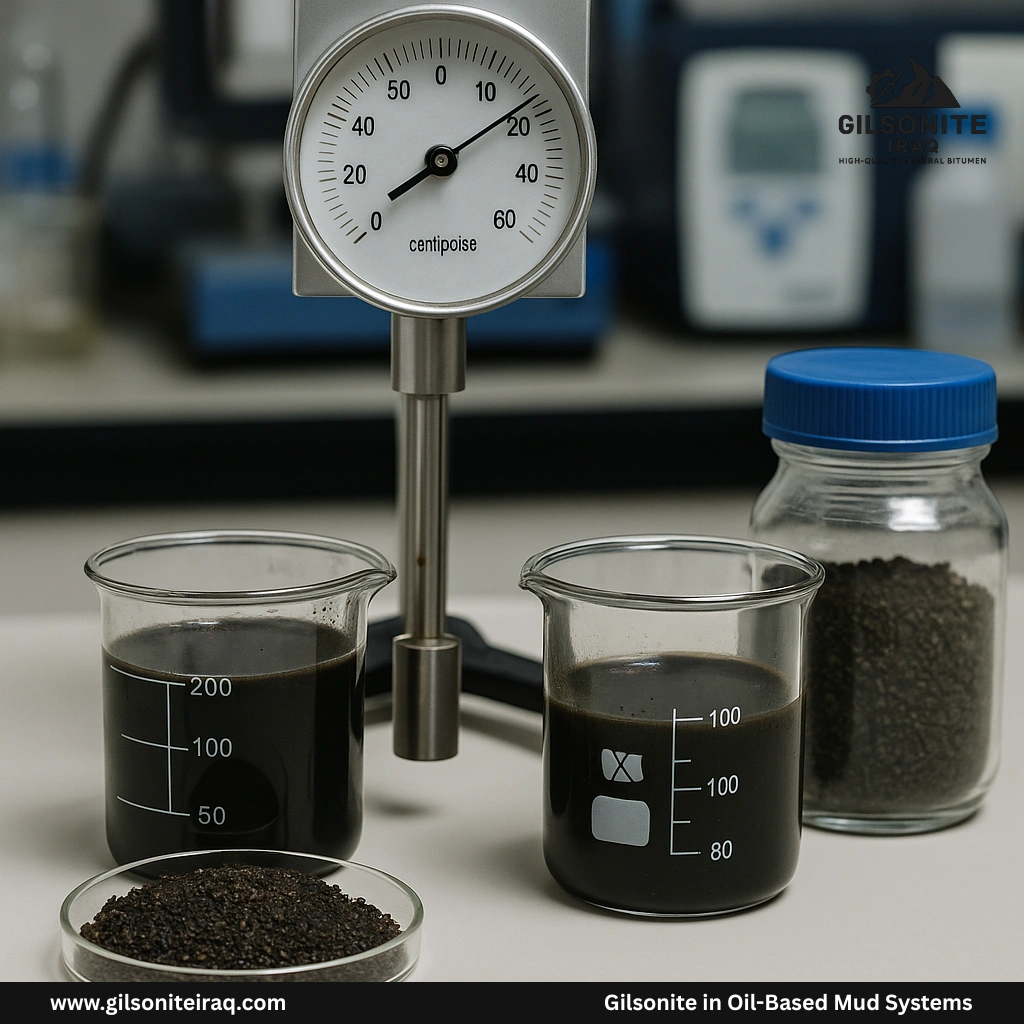Drilling fluid systems are among the most critical components of oil and gas well operations. Their main functions include cooling and lubricating the drill bit, carrying cuttings to the surface, controlling formation pressures, and stabilizing borehole walls.
The performance of a drilling fluid depends heavily on its rheological properties — parameters that describe how the fluid flows under various shear conditions.
In recent years, Gilsonite (natural asphalt) has gained widespread use as an additive in oil-based mud (OBM) formulations due to its excellent sealing, plugging, and stabilizing capabilities. This article explores how Gilsonite affects the rheology, filtration, and thermal behavior of OBMs, and why Iraqi Gilsonite is particularly suitable for high-performance drilling operations.
Role of Gilsonite in Oil-Based Mud Systems
Gilsonite is a naturally occurring hydrocarbon resin with a high carbon content (≈85%), low ash, and unique thermoplastic behavior. When introduced into drilling fluids, its laminar structure and partial solubility in base oils provide several key benefits:
- Acts as a plugging and sealing agent for micro-fractures and porous formations.
- Improves thermal stability of mud systems under HPHT (High Pressure High Temperature) conditions.
- Enhances fluid loss control by forming a thin, impermeable filter cake.
- Stabilizes shale formations by reducing osmotic interaction and filtrate invasion.
These effects are closely linked to changes in the rheological behavior of the mud — including plastic viscosity (PV), yield point (YP), and gel strength (GS).
Rheological Parameters Affected by Gilsonite
1. Plastic Viscosity (PV)
Plastic viscosity represents the resistance to flow due to internal friction between solid particles.
When Gilsonite (typically 2–6 wt%) is added to oil-based muds, PV values increase moderately due to better particle packing and lubricating dispersion. This helps maintain an ideal balance between flow resistance and suspension capacity, even at elevated temperatures.
2. Yield Point (YP)
The yield point measures the electrochemical attractive forces between suspended particles.
Gilsonite addition typically increases YP due to enhanced particle networking and solid-to-solid interactions.
A controlled increase in YP improves cutting suspension and hole cleaning, particularly in deviated wells.
3. Gel Strength (GS)
Gilsonite-modified OBMs demonstrate stable gel structures that prevent barite sagging during static periods.
The thermoplastic nature of Gilsonite ensures that gels break easily upon circulation restart — a desirable characteristic that reduces pump pressure spikes.
Source: Society of Petroleum Engineers
Effect of Temperature and Pressure
At high temperatures (above 180°C), conventional OBMs tend to lose viscosity and stability.
However, Gilsonite’s high softening point (≈200°C) ensures that the mud maintains structural integrity even in deep wells.
In HPHT drilling, Gilsonite helps:
- Preserve viscosity stability under extreme thermal conditions.
- Minimize filtrate loss and maintain a tight filter cake on the borehole wall.
- Enhance lubricity, reducing torque and drag on the drill string.
Filtration Control and Fluid Loss Reduction
One of the most important functions of Gilsonite is its ability to control fluid loss.
During filtration tests (API or HPHT), Gilsonite creates a fine-grained barrier that seals off microfractures and prevents filtrate penetration.
In oil-based muds, its partial solubility in the continuous oil phase allows it to form flexible, thermally stable layers that adapt to pressure fluctuations — preventing lost circulation events.
Research shows that a 2–5% Gilsonite addition can reduce HPHT fluid loss by up to 40–50%, depending on mud formulation and base oil type (diesel, mineral oil, or synthetic).
Compatibility with Other Additives
Gilsonite is chemically compatible with common OBM additives, including:
- Organophilic clays (for viscosity control)
- Emulsifiers (to stabilize water-in-oil systems)
- Lime and calcium compounds (to control alkalinity)
- Barite and hematite (for density control)
This compatibility makes it easy to incorporate Gilsonite during the mixing process without causing phase separation or emulsion instability.
Performance Comparison: Gilsonite vs. Graphite and Asphaltites
| Parameter | Gilsonite | Graphite | Asphaltite |
|---|---|---|---|
| Softening Point (°C) | 180–220 | 120–140 | 130–160 |
| Fluid Loss Reduction | Excellent | Moderate | Good |
| Thermal Stability | High | Very High | Moderate |
| Cost Efficiency | High | Low | Moderate |
| Solubility in Oil | Partial | Insoluble | Variable |
Conclusion: Gilsonite provides a balanced combination of cost-effectiveness, sealing performance, and thermal resilience, outperforming most alternatives in HPHT drilling environments.
Recommended Concentrations and Mixing Guidelines
| Parameter | Recommended Range |
|---|---|
| Gilsonite Concentration | 2–6 wt% of total mud volume |
| Mixing Temperature | 80–100°C |
| Stirring Time | 20–30 minutes |
| Particle Size | 75–200 μm |
| Optimal Oil/Water Ratio | 70:30 (w/w) |
Mixing Gilsonite at controlled temperatures ensures uniform dispersion and prevents agglomeration. Using a high-shear mixer or colloid mill enhances homogeneity.
Environmental Considerations
Unlike many synthetic polymers, Gilsonite is a natural and non-toxic additive. It contains no sulfur, heavy metals, or chlorinated compounds.
When used in OBMs, it reduces the total environmental footprint by replacing synthetic sealing agents.
Its biodegradability under long-term exposure also makes it suitable for environmentally friendly drilling practices in sensitive regions.
Conclusion
Gilsonite plays a crucial role in improving the rheological performance, fluid loss control, and thermal stability of oil-based mud systems.
Its unique combination of sealing and lubricating properties ensures safe, efficient drilling operations — particularly in high-temperature and high-pressure wells.
Given its high softening point and purity, Iraqi Gilsonite is especially well-suited for modern drilling applications across the Middle East and Asia.
By integrating Gilsonite strategically into OBM formulations, drilling engineers can achieve improved wellbore stability, reduced non-productive time (NPT), and significant cost savings.


